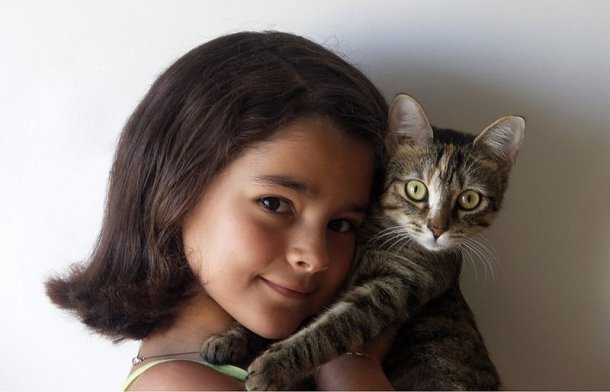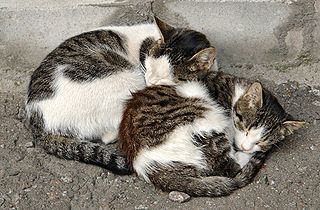What if human beings had the ability to heal themselves every time they spoke? It sounds like a superpower, but that’s what is happening every time your cat purrs. And that’s not all. Purring is a richly expressive felid vocalization, reflecting many of the most extreme moments of a cat’s life, both positive and negative.

Photo credit: Wikimedia commons
Why Cats Purr
Why do cats purr? Most of the time, humans express pain or anxiety very differently from pleasure. That may be why we assume purrs mean our cats are happy. Purring can definitely imply contentment in cats, but it may also signify anxiety, pain, fear or chronic ill health. As we will see, there is evidence that purring can even proactively relieve those stressors, providing therapeutic benefits for felines and their closest companions.

Cat purring in contentment (Photo credit: Monica / Flickr)
Kittens begin purring right after they are born; they learn to make their characteristic vibrations within a week of birth. The sound is first produced while nursing to reassure the mother cat and help her bond with her newborn kitten. Here, low-decibel purrs communicate comfort, pleasure and security.
Cats make use of a variety of meaningful vocalizations, from meows, wails and angry hisses to the soothing vibrations of the purr. Each vocalization serves a different purpose. A meow is functionally communicative, meant to directly convey specific messages like ‘feed me,’ ‘pet me’—or to connect with potential mates over long distances in the wild.
In a domestic situation, cats often use meows to get what they need or want, and then share gratifying purrs to show their appreciation. Some say that’s how cats train their human owners to attend to their wishes. Conversely, a purr is more expressive of internal states, although it’s not entirely clear whether it’s a voluntary or involuntary behavior.
The (Feline) Mozart Effect
If you observe a cat over time, you may notice that it purrs not only when it’s content, but also when it is stressed or in pain. Purring can be as much a signal that things are wrong as the opposite. Cats express both pleasurable and agitated feelings with purrs, particularly when those feelings are very intense.
Scientists have learned a lot in recent years about the value of certain regular, low-frequency sounds for healthy bone growth. Because purring rhythms alternate at a rate of about 25 to 150 Hertz, or vibrations per second, it has been hypothesized that purring promotes healing, not only by soothing stress but by literally stimulating bone mass and density. The properties of the vibrations create an ideal healing environment for the body, especially the bones of the skeleton.
 Elizabeth Von Muggenthaler presented this theory in 2001 at an international acoustical physics conference, in which she discussed the possibility of cats having evolved to purr for their health. “Is it possible that evolution has provided the felines of the world with a natural healing mechanism for bones and other organs?” Von Muggenthaler asked.
Elizabeth Von Muggenthaler presented this theory in 2001 at an international acoustical physics conference, in which she discussed the possibility of cats having evolved to purr for their health. “Is it possible that evolution has provided the felines of the world with a natural healing mechanism for bones and other organs?” Von Muggenthaler asked.
If true, that would mean ambient feline purring could help speed up the repair of bone fractures, muscle and tendon injuries, and wasting bone mass. It could also help relieve pain, stiff joints, and even labored breathing. It makes sense; cats do seem to heal from injuries and wounds at a freakishly fast rate.
Anatomy of a Purr
How is a purr created? First, the cat’s brain perceives pleasure or pain, which can be either external or internal. The brain then communicates rhythmic messages straight to muscles in the cat’s throat, known as the laryngeal muscles. It also sends these airborne sound waves to the cat’s diaphragm.
The distinctive passage of air in these channels causes the cat’s vocal cords to separate, opening the glottis and emitting the trademark sound of a feline purr. A tiny neck bone called the “hyoid” makes it possible for cats to purr continuously as they inhale and exhale in balletic cycles. What’s unique about this process is that it involves both inhalation and expiration. Unlike a meow, for example, purrs make use of the entire respiratory cycle.
Bonus Facts To Arouse Your Curiosity###
To Roar or to PurrNot every creature we think of as a ‘cat’ is capable of purring—only those in the Felidae family. Such “felids” include the Bobcat, Cheetah, Eurasian Lynx, the Cougar and the Wildcat, in addition to the furry domesticated kitties we keep as pets.
In contrast, creatures like lions, leopards, jaguars and tigers do not purr. These ‘cats’ roar instead, thanks to a special connective ligament in their throats that makes an intimidating roar possible. Interestingly, a cat either roars or it purrs—never both.
A Cure for the Microgravity Blues
Bones need the Earth’s gravity in order to maintain themselves. Skeletal bones are meant to support body weight; if they don’t, they simply atrophy away. This is the case for astronauts who spend a lot of time in the microgravity environment of outer space.
The absence of gravity means your bones sit in the dugout, serving no purpose. Inactivity steals away some 1% of bone mass every month from the bodies of astronauts. That means being in space is a lot like having osteoporosis. Could cats’ purring help solve this special problem? Some researchers say yes; the subject is still under study.
Yesterday’s Theories of Purr
Though the science of the purr is not complete, researchers are pretty confident about the basic process. This wasn’t always the case. In the past, several incorrect theories enjoyed credibility. Some speculated that cats had a special organ dedicated to purring. Another proposal suggested the purr was caused by blood passing through a large vein in the cat’s abdomen or by the sound of blood hitting the aorta artery in the throat.
Researchers knew they were on to something when they finally realized that cats afflicted with laryngeal paralysis can’t purr. Without the dutiful laryngeal muscles working to open and close the space between cats’ vocal cords, the familiar purring sound can’t be produced.